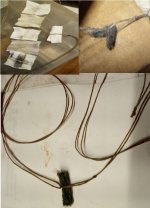Just a heads up, the dark stuff that comes out is graphite which is benign. Lead will appear as shimmering flakes...if patches don't have these flakes, either the approach is ineffective or the barrel is already clean.
I've been thinking about your comment that the dark stuff is graphite and is benign. But it has me more puzzled than before.
I shoot 25m HV (20 fpe) benchrest. Haven't gotten a 250 in a match but have been close. I am trying to reduce the spreads of my individual shots' POI versus the average POI, i.e., improve precision, in zero/ very low wind conditions. With my current setup, I find average spreads grow after about 130 pellets, all else equal, and probably are growing before that but within statistical error limits. What happens isn't so much that all pellets have higher spreads, but I'll get some "fliers" of 7 to 10 mm spread versus no shots over 5.5 mm spread in a clean, starting-out barrel. With a clean barrel, my spreads typically average 1.6 to 2.2 mm for a 15 shot sequence. With a "dirty" barrel that hasn't been cleaned after 130 shots, the spreads can average more like 2.5 to 3.5 mm
So I pull dry patches through my barrel after every 30 or so shots, and clean my barrel with wet then dry patches after about 100 shots during practice sessions. The patches are inevitably dirty. It takes about 4 wet patches (using WD-40) to remove the "dark stuff". (Also, I lube my pellets with WD-40 as Mike
@thomasair has recommended.) I have never seen a shiny fleck of lead in the dry or wet patches*, so I assumed the build-up of dark stuff was increasing the chances of shooting a 7 to 10 mm "flier".
(* I did once see a lead speck on a patch. I was experimenting with treating the barrel and pellets with hexagonal boron nitride (HBN). I got hardly any dark stuff on my dry or wet patches, but spreads were not very good. And then one dry patch yielded the lead speck. I don't use HBN anymore).
Can you help me interpret all this? Could the dark stuff (graphite) build-up be impacting my spreads? Might there actually be lead flecks but I am not looking for them properly?
My other problem is that I seem to need to shoot 10-20 pellets after a wet cleaning before the precision tightens up. I know you've supported the approach of using wax after a thorough solvent clean of a barrel and then not needing fouling shots. But I've not had this success after using wax or with WD-40 patches.
Regards.
 patchworm.com
patchworm.com 
